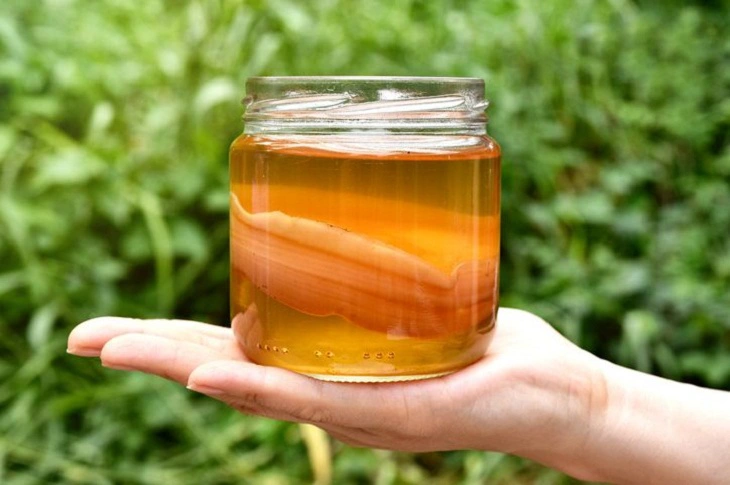Greetings, fellow tea enthusiasts! If you’re intrigued by the magical elixir known as Kombucha and eager to learn how to make Kombucha at home, you’ve come to the right place. In this comprehensive guide, we’ll walk you through the process of creating your own delicious and probiotic-rich Kombucha. So, put on your brewing hat and let’s get started on this delightful adventure!
What Is Kombucha?
Kombucha is a fermented beverage that is created through the fermentation of sweetened tea by a symbiotic culture of bacteria and yeast (SCOBY). The resulting drink is known for its tangy, slightly sweet, and effervescent taste. It has been consumed for centuries, particularly in certain parts of Asia, and has gained popularity around the world in recent years for its potential health benefits.
The fermentation process involves the following steps:
- Tea Preparation: Black or green tea is commonly used as the base for kombucha. The tea is brewed and sweetened with sugar to provide nutrients for the fermentation process.
- Addition of SCOBY: The SCOBY, which looks like a rubbery disc, is added to the sweetened tea. The SCOBY contains a colony of beneficial bacteria and yeast that initiate the fermentation process.
- Fermentation: The SCOBY metabolizes the sugars in the tea, producing various compounds such as organic acids (like acetic acid), vitamins, enzymes, and trace amounts of alcohol. This fermentation process typically takes about one to two weeks.
- Flavor Development: As the fermentation progresses, the kombucha develops its characteristic flavor profile, ranging from slightly tart to more tangy, depending on the fermentation time.
- Bottling and Carbonation: Once the desired flavor is achieved, the kombucha is usually strained and transferred to bottles. It can be consumed at this stage, but many people choose to do a secondary fermentation by sealing the bottles to allow carbonation to develop, creating the characteristic fizziness.
Kombucha is enjoyed for its potential health benefits, which include probiotics (beneficial bacteria for gut health), antioxidants, and B vitamins. However, it’s important to note that scientific research on the health benefits of kombucha is still ongoing, and individual reactions to the beverage can vary.
Commercially available kombucha may also come in various flavors, as fruits, herbs, and spices can be added during or after fermentation to create unique taste profiles. While kombucha is generally considered safe for consumption, homemade versions should be prepared with care to ensure proper hygiene and fermentation conditions.
Gather Your Supplies
Before embarking on your Kombucha-making journey, make sure you have the necessary supplies. Here’s a handy list:
- Quality Ingredients:
- Tea: Opt for black, green, or a blend of herbal tea to use as the base for your Kombucha.
- Sugar: Choose organic cane sugar or white sugar as a nutrient source for the fermentation process.
- Water: Use filtered or distilled water for optimal results.
- Brewing Equipment:
- Large Pot: To brew the tea and dissolve the sugar.
- Fermentation Vessel: A glass jar or ceramic crock that can hold your Kombucha while it ferments.
- Breathable Cover: A tight-weave cloth or coffee filter to cover the fermentation vessel.
- Rubber Band: To secure the cover tightly in place.
- pH Strips: For measuring the acidity of your Kombucha.
- Starter Culture:
- SCOBY: Acquire a healthy Symbiotic Culture of Bacteria and Yeast (SCOBY) from a reliable source. It kick-starts fermentation.
Brewing Your Kombucha
- Prepare the Tea Base:
- Bring water to a boil and remove it from heat.
- Add tea bags or loose tea to the hot water and steep for the recommended time.
- Remove the tea bags or strain the loose tea and stir in the sugar until it dissolves.
- Cool Down the Tea:
- Allow the sweetened tea to cool completely to room temperature.
- Never add the SCOBY to hot tea, as it can harm the culture.
- Introduce the SCOBY:
- Gently place the SCOBY into the cooled tea.
- If available, add some starter liquid from a previous batch of Kombucha to acidify the environment.
- Cover and Ferment:
- Cover the fermentation vessel with the breathable cover, securing it with a rubber band.
- Place the vessel in a warm, well-ventilated area away from direct sunlight.
- Let the Kombucha ferment for 7 to 14 days, tasting periodically to achieve your desired flavor.
- Harvest and Bottle:
- Once the desired taste is achieved, carefully remove the SCOBY and set it aside with some starter liquid for your next batch.
- Pour the fermented Kombucha into clean glass bottles with airtight lids, leaving a small amount of headspace.
- Optionally, you can add fruit juice or flavorings to the bottles for a second fermentation.
- Second Fermentation (Optional):
- Seal the bottles tightly and allow them to undergo a second fermentation at room temperature for 1 to 7 days.
- This process creates carbonation in the Kombucha.
- After the second fermentation, refrigerate the bottles to slow down carbonation and enjoy chilled Kombucha.
Types of Tea Base for Kombucha
| Tea Type | Flavor Profile | Brewing Time |
|---|---|---|
| Black Tea | Bold, robust, and malty | 3-5 minutes |
| Green Tea | Fresh, grassy, and vegetal | 2-3 minutes |
| Herbal Tea | Fragrant and caffeine-free | Varies by blend |
FAQs:
- How long does it take to brew Kombucha?
The brewing time can vary based on personal preference and environmental conditions. Generally, it takes 7 to 14 days for the initial fermentation and an additional 1 to 7 days for the second fermentation (if desired). - Can I use flavored teas or tea blends for Kombucha?
Yes, you can experiment with various flavored teas or tea blends to create unique Kombucha flavors. Just ensure they do not contain oils or additives that may harm the SCOBY. - How do I know if my Kombucha is safe to consume?
Look for signs of a healthy fermentation process such as a mildly acidic smell, a tangy taste, and the formation of a new SCOBY on top. If you notice any mold, foul odor, or unusual colors, it’s best to discard the batch and start fresh.
Conclusion:
Congratulations, brewing maestros! You have now unlocked the secrets of crafting your very own Kombucha. By following these steps and experimenting with different tea bases and flavors, you can create a variety of tantalizing Kombucha concoctions to delight your taste buds. Embrace the art of fermentation and enjoy the probiotic goodness of this ancient elixir with every sip!
Fun Fact:
Did you know that the SCOBY used to make Kombucha can reproduce and create “baby” SCOBYs? This is why Kombucha brewing becomes a never-ending adventure of SCOBY growth!
Originally posted 2023-07-07 15:30:05.




